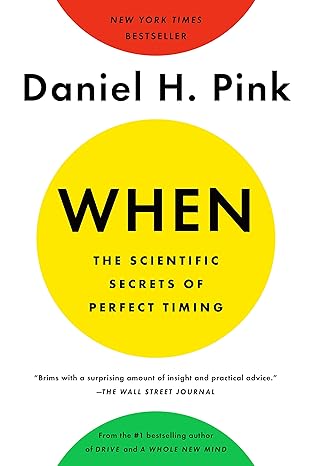
When: The Scientific Secrets of Perfect Timing - by Daniel H. Pink
Date read: 2018-04-28How strongly I recommend it: 8/10
(See my list of 150+ books, for more.)
Go to the Amazon page for details and reviews.
Goes into detail on when we are at our best and our worse. Good insight into how to optimize your day to include certain activities when you're at your best and most depleted. Recommended for those that have their schedules under control but are looking for ways to improve throughput by knowing when to do certain types of tasks.
Contents:
My Notes
Positive affect-language revealing that tweeters felt active, engaged, and hopeful-generally rose in the morning, plummeted in the afternoon, and climbed back up again in the early evening.
[A]n important takeaway from our study for corporate executives is that communications with investors, and probably other critical managerial decisions and negotiations, should be conducted earlier in the day.
Our cognitive abilities do not remain static over the course of a day. During the sixteen or so hours we're awake, they change-often in a regular, foreseeable manner. We are smarter, faster, dimmer, slower, more creative, and less creative in some parts of the day than others.
How we do depends on what we're doing. "Perhaps the main conclusion to be drawn from studies on the effects of time of day on performance,is that the best time to perform a particular task depends on the nature of that task."
For most of us, those sharp-minded analytic capacities peak in the late morning or around noon.
Alertness and energy levels, which climb in the morning and reach their apex around noon, tend to plummet during the afternoons.
For analytic problems, lack of inhibitory control is a bug. For insight problems, it's a feature. Some have called this phenomenon the "inspiration paradox"-the idea that "innovation and creativity are greatest when we are not at our best, at least with respect to our circadian rhythms."
What ultimately matters, then, is that type, task, and time align-what social scientists call "the synchrony effect."
All of us experience the day in three stages-a peak, a trough, and a rebound. And about three-quarters of us (larks and third birds) experience it in that order. But about one in four people, those whose genes or age make them night owls, experience the day in something closer to the reverse order-recovery, trough, peak.
High performers, its research concludes, work for fifty-two minutes and then break for seventeen minutes.
Short breaks are effective-and deliver considerable bang for their limited buck. Even "micro-breaks" can be helpful.
Simply standing up and walking around for five minutes every hour during the workday can be potent.
Taking a few minutes to be in nature is better than spending those minutes in a building.
Healthy adults should ideally nap for approximately 10 to 20 minutes.
Caffeine, usually in the form of coffee, followed by a nap of ten to twenty minutes, is the ideal technique for staving off sleepiness and increasing performance.
Midpoints are both a fact of life and a force of nature, but that doesn't make their effects inexorable. The best hope for turning a slump into a spark involves three steps: